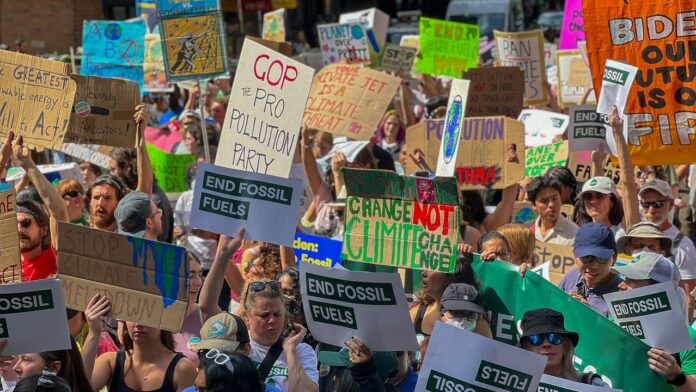Keeping movements alive is hard work—they run on volunteer energy, and they can be derailed by too much success, too much failure, too much internal strife, too many competing interests. Or they can be hindered by a pandemic, which largely brought the climate movement to a halt just months after its biggest single day, in September of 2019, when millions of people around the world, most of them young, took to the streets; in New York City, according to organizers, a quarter million of them joined the then sixteen-year-old Swedish climate activist Greta Thunberg down at the Battery.
Sunday’s March to End Fossil Fuels was not as big—Representative Alexandria Ocasio-Cortez, in a rousing wrap-up speech at the end of the day, estimated the crowd at between fifty and seventy thousand people, the organizers said seventy-five thousand, and the Times went with “tens of thousands.” But that didn’t matter—the march was considerably larger than organizers had expected, and represented a real return to the streets for climate campaigners. I wandered back and forth along the line of march, which went from Broadway in the fifties crosstown to First Avenue, near the United Nations; the sun was bright, spirits were high, and the signs were clever. (“Leonardo DiCaprio’s Girlfriends Deserve a Future.”)
I knew many of the people leading the parade: Third Act, the progressive group for people over sixty that I helped found, sent chapters from Ohio, Pennsylvania, Vermont, Connecticut, New Hampshire, Massachusetts, and across New York; and there were such veteran organizers as the Reverend Lennox Yearwood, of the Hip Hop Caucus, and Naomi Klein, who took time off from her book tour for the newly released “Doppelganger” to attend. Clearly, the climate movement, led by Indigenous groups and frontline communities, has come through the past few years intact; enormous credit is due to the organizers, including Jean Su, of the national N.G.O. the Center for Biological Diversity (“Our Mission: Saving Life on Earth”), who pulled together a major march in a matter of months.
Yet, just as clearly, this movement needs to expand again. Campaigns draw their structure from the committed activists at the core, but they draw their power from the large numbers of less intensely engaged citizens that they can entice in for a little while; victory for movements means somehow reaching into the broad middle and convincing people that they can play an important role, even if they do so just temporarily. In September of 2014, for instance, a climate march across Manhattan drew as many as four hundred thousand marchers. They came less because of existential fear (2014 was practically an ice age compared with the heat and fire we’ve seen this summer) than because they sensed a chance to send a message ahead of the Paris climate talks, and their message was heard. Here’s President Barack Obama speaking at the U.N. two days later:
Representative Ocasio-Cortez repeated that theme yesterday. “That means something,” she told marchers. “I’m in rooms in Washington all the time where people say that they have a commitment to this issue, but we need urgency.” She may have been thinking of President Biden, who will address the U.N. General Assembly on Tuesday. At various points in the proceedings, the audience booed at the mention of his name, for having granted permits for new fossil-fuel projects, but they also reserved their loudest cheers for Ocasio-Cortez, who, of course, has endorsed Biden for reëlection; clearly, there’s at least some understanding of the political realities around the beckoning campaign.
I talked to marchers who thought that the attendance should have been higher, given a summer that featured what were likely the highest temperatures in a hundred and twenty-five thousand years, and the Canadian wildfire smoke that filled the skies of American cities, and the epic flooding taking a horrific toll in Libya. But it takes time to grow—or regrow—movements, and the good vibe from this one will make the next such day easier to recruit for. We don’t have endless time, of course. But yesterday was a crucial, jaunty step. The world was marching again. ♦


